Ælfgif-who? provides short biographies of early medieval English women every two weeks. Click on the podcast player if you’d like to hear this newsletter read aloud in my appealing Yorkshire accent.

Saint Eanswith: First Abbess of Folkestone, Found After 1400 Years
Eanswith (or Eanswythe) was a Kentish princess, thought to be the founder of Folkestone Abbey, who has been a local saint since her death in the seventh century. Her Feast Day is on the 12th September. Like Lady Godiva or Saint Bega, she is a woman whose story is part history, part legend. While we have evidence that she was a real woman, her story has been filled in over the centuries with details that are difficult to trace back to the historical Eanswith. Textual sources provide few clues to Eanswith’s life, but a recent archaeological find has brought her into the twenty-first century.
The major historical source for her existence is the Kentish Royal Legend, a list of Kentish saints. This text is believed to be from the eighth century, though the original is now lost. A tenth-century version mentions Eanswith in passing, when it says:
Then was Imma, daughter of the king of the Franks, Eadbald’s queen; and she begot Saint Eanswith, who rests at Folkestone, and Earconberht, king of Kent, and aetheling Eormenred.
A later version from the mid-eleventh century contains the added detail that Folkestone is ‘the minster [Eanswith] herself founded’. Though these are only cursory mentions, they allow us to place Eanswith in a historical context. She was a Kentish royal woman: the granddaughter of the Frankish Christian Bertha and her husband the Christian convert King Æthelberht. Bede tells us that Eanswith’s father, King Eadbald, was not a Christian when he acceded to the Kentish throne, and went on to scandalously marry his own stepmother, presumably Æthelberht’s second wife after Bertha. This controversial act against Church law caused a crisis in Kent, which was in the process of being converted to Christianity by missionaries from Rome – the bishops of London and Rochester both left England in response. Bede says that in 624, after suffering fits of insanity and demonic possession as divine punishment for his actions, he had a change of heart, repudiated his wife and was baptised into Christianity. Eanswith and her brothers were the result of a second marriage to Imma, so we can date Eanswith’s birth to some time after 624, and before 640 when Eadbald died.
Eanswith was thus born at a time when Christianity was beginning to take a permanent hold at the Kentish court. Crucially, if the eleventh-century source is correct about her being the founder of Folkestone, this would make her one of the first English abbesses. Some have posited that Eanswith was the first English abbess, although this is difficult to prove. According to Kentish tradition Lyminge was founded by her aunt Æthelburg in 633 when Eanswith could have been no older than nine. Kentish women such as Eanswith’s niece Eorcengota were still travelling across the channel to become nuns a generation later, implying there may not yet have been a nunnery they could enter. The evidence for these early Kentish houses is simply too patchy to make any firm conclusions about which came first.
There is one other piece of evidence that could corroborate that Eanswith founded Folkestone: a charter, dated 799 but forged in the tenth century, includes a clause that refers to the ‘land of Saint Eanswith’. Forged charters, designed to back up or create historical claims to land, often replicated some of the wording of original charters to create a sense of authenticity – this clause may well have been copied from an earlier charter. Even if this wording is not from an earlier charter, the strong association between Eanswith and Folkestone that clearly existed in the tenth and eleventh centuries is an indication that she was remembered as its founder.
This association between Eanswith and Folkestone endured. In the thirteenth century, a monk of Folkestone collected all the known stories about the now legendary Eanswith and put them together in a saint’s life. This only survives in an abridged and edited version included in a fourteenth-century collection of saints’ lives, which was damaged in the Cotton Fire of 1731. This Life tells us that Eadbald built Folkestone for Eanswith. While the monastery was being built, it is said that she was courted by a non-Christian king of Northumbria. She challenged him to ask his gods to make one of the roof beams that had been cut too short longer, and he failed. She then prayed to her Christian God and the beam grew. It seems unlikely that this story provides much factual detail about Eanswith’s life – there is no explanation as to why she should agree to court a king while having a monastery built for her. Her story is likely being cross-pollinated with that of her aunt, Æthelburg, who married King Edwin of Northumbria, and who had a monastery founded for her by her brother in her widowhood. The miracle of the growing beam is also a common story, most notably in the Apocryphal Gospels denoting the life of Jesus as a boy. There are a number of other miracles: Eanswith makes water flow uphill, brings a goose back to life from the bones of its carcass, and cures a blind woman’s sight. The author tells us that some time after her death, due to the cliff subsistence of the cemetery, her bones were moved inside the church. After this she performed a number of posthumous healing miracles - a fairly standard account of an early medieval saint.
The written source material does not tell us much that we can trust about Eanswith or her life. The Kentish Royal Legend’s comments are brief and not contemporary, the charter is spurious, and the monk’s Life of Eanswith was written centuries later and has been abridged by a third party. With no contemporary account of her life, her biography might be little more than an acknowledgement of her existence, her family, some later miracle stories and her connection with Folkestone. Very little in the textual sources is concrete.
However - in 1885, workmen removing plaster in the church of St Mary and Eanswythe in Folkestone found a twelfth-century lead reliquary in a wall of the church. This reliquary was full of bones that made up about half of a human skeleton. While some suspected these bones might belong to the church’s namesake and Folkestone’s founder Eanswith, there was a possibility they were fake medieval relics. The Diocese of Canterbury recently permitted scientific analysis on the bones as part of the Finding Eanswythe project. They could not be removed from the building due to their religious significance, so researchers set up a lab in the church, even sleeping there overnight. Analysis concluded that the bones were from a female skeleton, a woman who died when she was between 17 and 20 years old, sometime between the years 653 and 663. Given that the date and age fit Eanswith’s likely birth date, and given there are no other possible candidates in the historical record for a female saint from this time in Folkestone other than Eanswith, it can be concluded that this is her skeleton. These are the earliest verified remains of an English saint. Church records suggest her bones were translated into the church in the twelfth century. It is also known that there was a shrine to her there in the 1530s - these bones were likely hidden in the wall to protect them during the reformation. The community at Folkestone ensured their survival, and will continue to do so.
Despite Eanswith’s relative obscurity in the written record, her memory has been kept alive by the people of Folkestone for more than 1400 years. The discovery of what are almost certainly her bones brings her even more concretely into our modern world. After all this time, Saint Eanswith’s history is still being written.
Suggestions for further reading:
More information about Eanswith can be found on the website of the Finding Eanswythe website, which provides information about the historical woman, the legends that have built around her, as well as her significance to the locality of Folkestone.






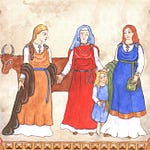
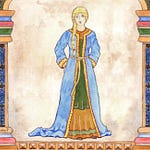
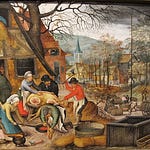
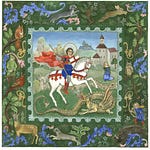



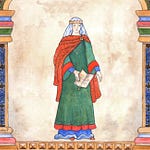
Share this post